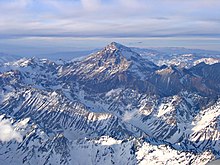Dominance (geography)

In geography, dominance is understood as the radius of the area that towers above a peak , mountain or other geomorphological landform . In addition to the notch height, dominance is the most important criterion for classifying a peak as an independent mountain.
determination
The dominance of a mountain can be determined as the distance to the nearest point of the same height at the foot or slope of a higher mountain. It is given as a length. A mountain with dominance x km is therefore the highest elevation within a x km radius .
In order to determine the dominance of a mountain, one measures the minimum distance of the summit to the next contour line of the same height of a higher summit. If the mountain is very dominant, so that the curvature of the earth has to be taken into account, the distance can be calculated from the coordinates of the two points using an orthodrome .
While the dominance is measured in a direct line to the next higher peak, the notch height is measured along the course of the ridge. The reference mountains for the notch height are not necessarily the same as for the dominance.
The dominance should not be confused with the concept of orographic dominance developed by Eberhard Jurgalski , in which the height of a mountain is compared to its height.
Examples
- The from the summit of 2962 m above sea level. NHN high Zugspitze from next 2962 meter height line surrounds the Zwölferkogel ( 2988 m ) in the Stubai Alps . The distance between the Zugspitze and this contour line is 25.8 km as the crow flies; the Zugspitze is the highest point within a radius of 25.8 km. Their dominance is thus 25.8 km.
- Since there is no higher summit than Mount Everest on planet earth (but see for example: Olympus Mons on Mars ) , it does not have finite dominance. Some sources list the circumference of the earth over the poles or half the circumference of the earth as a makeshift dominance .
- After Mount Everest, Aconcagua , the highest mountain on the American double continent, has the greatest dominance of all mountains. Only 16,534 km away is it exceeded in height by the Tirich Mir in the Hindu Kush .
- The Mont Blanc is the highest mountain in the Alps . The geographically next higher mountains are in the Caucasus . The the Elbrus (5642 m) obvious Kjukjurtlju (4912 m) is dominance reference for mountain Mont Blanc in 2812 km distance.
Lists
- List of mountains by dominance
- List of the most dominant mountains in Europe
- List of the most dominant mountains in Germany
- List of the most dominant mountains in Thuringia
See also
Individual evidence
- ↑ Alpendominanzen on extreme-collect.de
